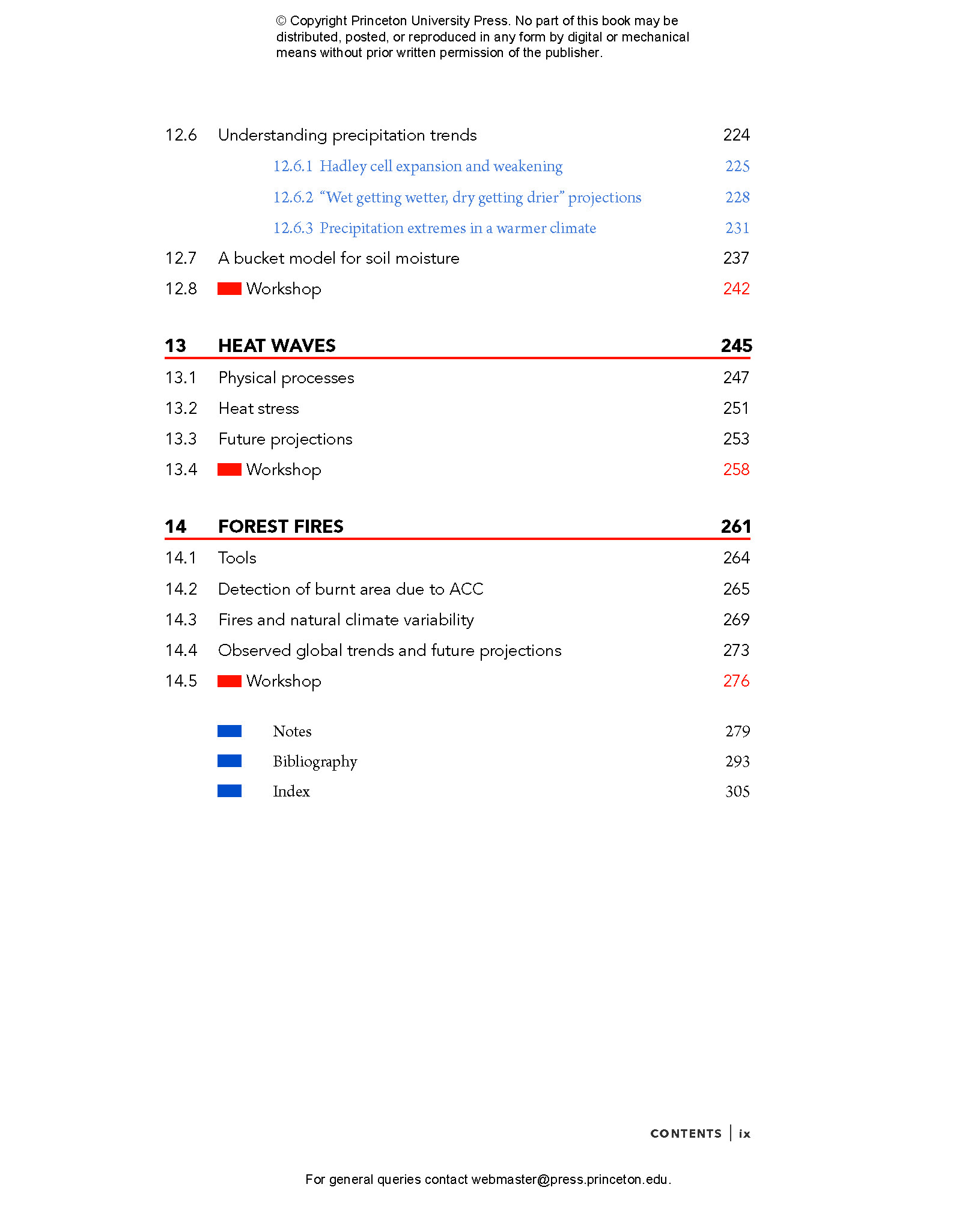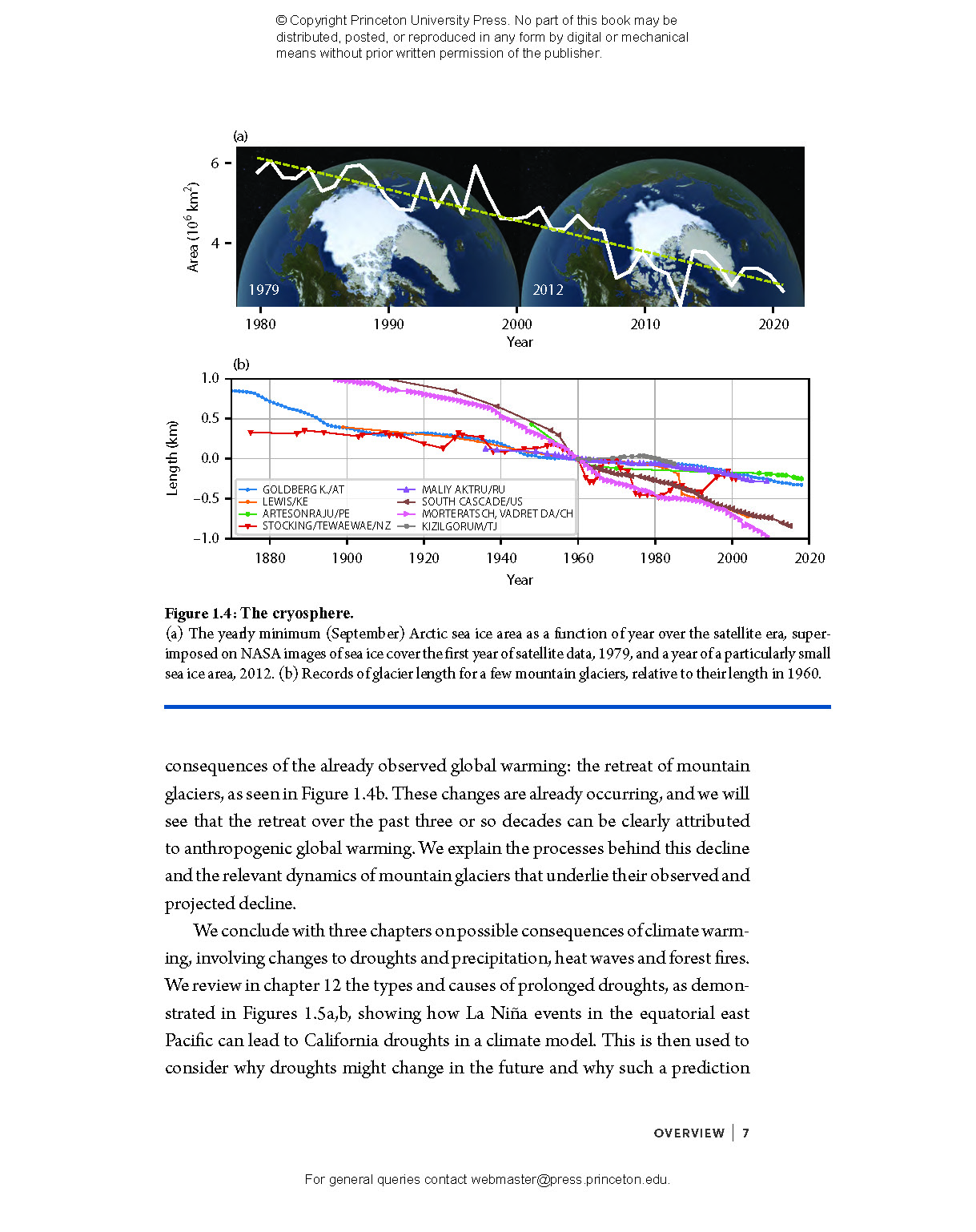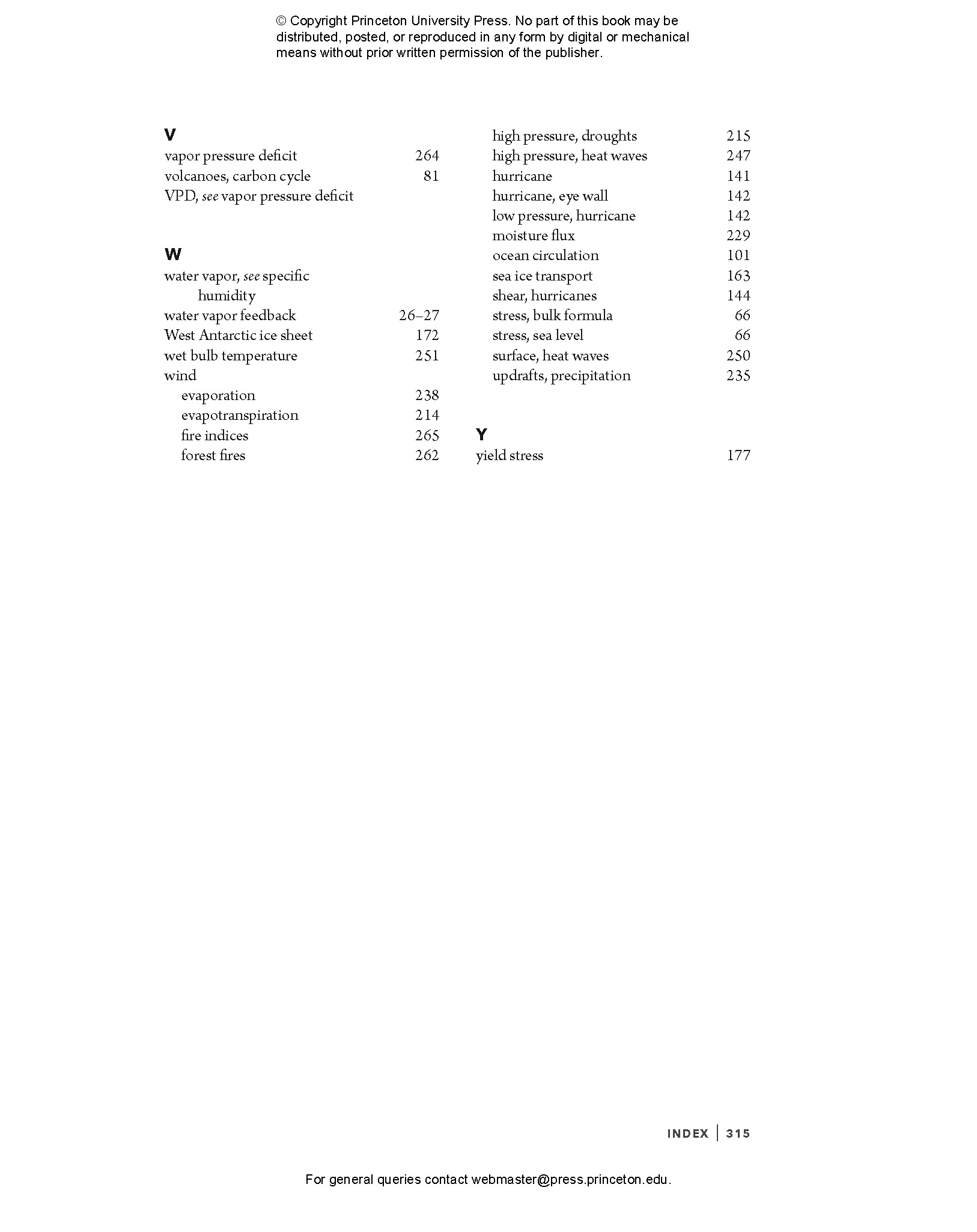This textbook introduces undergraduates to the concepts and methods of global warming science, covering topics that they encounter in the news, ranging from the greenhouse effect and warming to ocean acidification, hurricanes, extreme precipitation, droughts, heat waves, forest fires, the cryosphere, and more. This book explains each of the issues based on basic statistical analysis, simple ordinary differential equations, or elementary chemical reactions. Each chapter explains the mechanisms behind an observed or anticipated change in the climate system and demonstrates the tools used to understand and predict them. Proven in the classroom, Global Warming Science also includes “workshops” with every chapter, each based on a Jupyter Python notebook and an accompanying small data set, with supplementary online materials and slides for instructors. The workshop can be used as an interactive learning element in class and as a homework assignment.
- Provides a clear, broad, quantitative yet accessible approach to the science of global warming
- Engages students in the analysis of climate data and models, examining predictions, and dealing with uncertainty
- Features workshops with each chapter that enhance learning through hands-on engagement
- Comes with supplementary online slides, code, and data files
- Requires only elementary undergraduate-level calculus and basic statistics; no prior coursework in science is assumed
- Solutions manual available (only to instructors)
Eli Tziperman is professor of oceanography and applied physics in the Department of Earth and Planetary Sciences and the School of Engineering and Applied Sciences at Harvard University.
- Preface
- 1 OVERVIEW
- 2 GREENHOUSE
- 2.1 The greenhouse effect
- 2.1.1 Earth’s energy balance
- 2.1.2 The greenhouse effect: a two-layer model
- 2.1.3 The emission height and lapse rate
- 2.2 Greenhouse gases
- 2.2.1 Wavelength-dependent black-body radiation
- 2.2.2 Energy levels and absorption
- 2.2.3 Broadening
- 2.2.4 Radiative forcing, logarithmic dependence on CO2
- 2.2.5 Other greenhouse gases, global warming potential
- Box 2.1: The Clausius-Clapeyron relation
- 2.2.6 The water vapor feedback
- 2.3 Workshop
- 3 TEMPERATURE
- 3.1 Climate sensitivity and the role of the ocean
- 3.1.1 Equilibrium climate sensitivity
- 3.1.2 Transient climate sensitivity
- 3.2 Polar amplification
- 3.3 “Hiatus” periods
- 3.4 Stratospheric cooling
- 3.4.1 Detection and attribution
- 3.5 Workshop
- 4 SEA LEVEL
- 4.1 Global mean sea level changes
- 4.1.1 Thermal expansion
- Box 4.1: Past warm climates
- 4.1.2 Ice sheets and mountain glaciers
- 4.1.3 Land water storage
- 4.1.4 Detection of anthropogenic climate change in GMSL
- 4.2 Regional sea level changes
- 4.2.1 Atmosphere-ocean interaction
- 4.2.2 Land changes
- 4.2.3 Gravitational effects: sea level fingerprints of melting
- 4.3 Workshop
- 5 OCEAN ACIDIFICATION
- 5.1 Calcium carbonate (CaCO3) dissolution
- Box 5.1: The carbon cycle
- 5.2 The carbonate system
- 5.2.1 Carbonate system equations
- 5.2.2 Approximate solution of the carbonate system
- 5.3 Response to perturbations
- 5.3.1 Response to increased atmospheric CO2 concentration
- 5.3.2 Response to warming
- 5.3.3 Long-term decline of anthropogenic CO2
- 5.4 Workshop
- 6 OCEAN CIRCULATION
- Box 6.1: Ocean temperature, salinity, and water masses
- 6.1 Observations and projections
- 6.2 The Stommel model
- 6.3 Multiple equilibria, tipping points, hysteresis
- 6.4 Keeping it simple
- 6.5 Consequences of AMOC collapse
- 6.6 The oceans and global warming
- 6.7 Workshop
- 7 CLOUDS
- 7.1 Cloud fundamentals
- 7.2 Moist convection and cloud formation
- 7.3 Cloud microphysics
- 7.4 Cloud feedbacks and climate uncertainty
- 7.5 Workshop
- 8 HURRICANES
- 8.1 Factors affecting hurricane magnitude
- 8.2 Potential intensity
- Box 8.1: El Niño, La Niña
- 8.3 Observed changes to hurricane activity
- 8.4 Workshop
- 9 ARCTIC SEA ICE
- 9.1 Processes and feedbacks
- 9.2 Detection of climate change
- 9.3 Future projections
- 9.4 Workshop
- 10 GREENLAND AND ANTARCTICA
- 10.1 Terminology
- 10.2 Processes
- 10.2.1 Accumulation
- 10.2.2 Surface melting and PDD
- 10.2.3 Calving
- 10.2.4 Ice flow
- 10.2.5 Basal hydrology
- Box 10.1: Ice ages
- 10.3 Observed trends and projections
- 10.4 Workshop
- 11 MOUNTAIN GLACIERS
- 11.1 Observed retreat
- 11.2 Mountain glaciers as a climate indicator
- 11.2.1 Reconstructing temperature from glacier extent
- 11.2.2 Ice cores from mountain glaciers
- 11.3 Glacier dynamics
- 11.4 Mountain glacier retreat in perspective
- 11.5 Workshop
- 12 DROUGHTS AND PRECIPITATION
- 12.1 Relevant processes and terms
- 12.2 Why droughts happen, climate teleconnections
- Box 12.1: The Indian Ocean dipole
- 12.3 Detection of climate change
- 12.4 Observations, paleo proxy data
- 12.5 Example projections: Southwest United States and the Sahel
- 12.6 Understanding precipitation trends
- 12.6.1 Hadley cell expansion and weakening
- 12.6.2 “Wet getting wetter, dry getting drier” projections
- 12.6.3 Precipitation extremes in a warmer climate
- 12.7 A bucket model for soil moisture
- 12.8 Workshop
- 13 HEAT WAVES
- 13.1 Physical processes
- 13.2 Heat stress
- 13.3 Future projections
- 13.4 Workshop
- 14 FOREST FIRES
- 14.1 Tools
- 14.2 Detection of burnt area due to ACC
- 14.3 Fires and natural climate variability
- 14.4 Observed global trends and future projections
- 14.5 Workshop
- Notes
- Bibliography
- Index
"This book and its associated materials provide an excellent pathway for developing a rigorous understanding of the challenges that human society is likely to face in coming decades."—I. D. Sasowsky, CHOICE
“In this masterful book, Tziperman uses simple quantitative models to provide insights into complex problems. Global Warming Science gives students the tools they need to make their own discoveries and tackle new problems.”—Mark Cane, Columbia University
“Tziperman elegantly addresses many of the central aspects of global warming, providing an excellent introduction for students and an invaluable refresher for active researchers.”—Isaac M. Held, Princeton University
“Global Warming Science is a wonderful resource for anyone seeking to ground their understanding of climate change in the physics of the climate system. With clear explanations coupled to mostly unintimidating math, Tziperman leads readers from first principles to the big-picture processes that control heat waves, sea level, droughts, and wildfire. All of us who work on climate change can benefit from the way this book links the ‘what’ of climate change to the ‘why’ and ‘how.’”—Chris Field, Stanford University
“An exceptionally lucid, concise, and readable textbook that will be enjoyed by undergraduate students seeking to learn about the current newsworthy subject of climate change at a more rigorous level.”—Kerry Emanuel, author of What We Know about Climate Change
“My overall impression of this book is that I love it. Tziperman has written an engaging, fun-to-read textbook that fills an important gap, and I expect that it will be enthusiastically received by instructors teaching quantitative undergraduate climate courses. A simply excellent contribution.”—Jonathan M. Gilligan, coauthor of Beyond Politics: The Private Governance Response to Climate Change
with jupyter notebooks, data and course slides




























